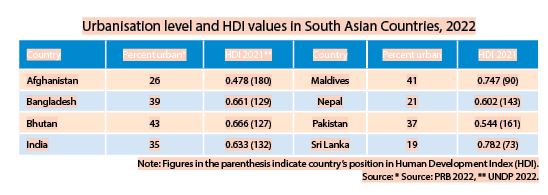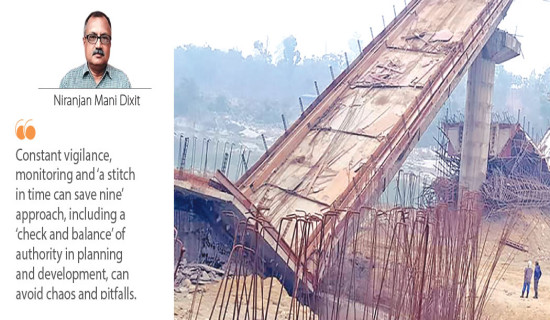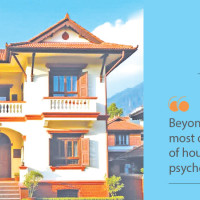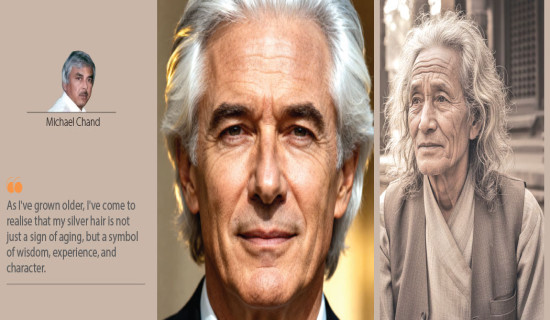- Wednesday, 26 November 2025
Anomalies In Nepal's Urbanisation Drive
Conventionally, one of the measures of the development status of a country is its level of urbanisation. World urbanisation data suggests that more developed countries are highly urbanized. For example, according to data from the Population Reference Bureau, in 2022, 79% of the population in more developed countries will live in urban areas, while the corresponding figures for less developed and least developed countries are 53% and 35%, respectively.
Nepal’s urbanisation is interesting and unique because its Urbanisation level and its development status hardly correlate. There were only 58 urban municipalities at the time of the Population and Housing Census 2011, and the Urbanisation level was 17.1%. It was low by all international standards.
Before the 2001 population census, it was in 1997 that the government of Nepal declared 22 municipalities over the existing 36 municipalities. The government did not pay attention in this direction for more than 15 years despite several village development committees and areas adjacent to the then urban municipalities meeting population and other related indicators for municipal status between 1997 and 2014.
In between, two decennial censuses were carried out. But amidst the country’s struggle for a new constitution and state restructuring, between 2014 and 2016, a number of village development committees were successively declared urban municipalities. With the Constitution of Nepal 2072 (2015), the country adopted a federal structure with three tiers of government: federal, provincial, and local. Subsequently, a commission was formed for the territorial restructuring of local bodies. Based on the report of the commission and with some additional homework from the government, after the new constitution but before the first local election, the country ended up with 753 local government bodies, of which 293 were nagarpalika (urban municipalities).
The adjusted urban population for 293 nagarpalika based on the population and housing census of 2011 came out to be 16,740,732 by then, which meant 63.2% of the total population lived in urban municipal areas. That's an increase of 270 percent over the 2011 census. Perhaps nowhere in the world has such rapid urban population change or growth happened in such a short period of time. This massive urban growth, due to the reclassification and annexation, has not only provided misleading information about the actual level of Urbanisation in the country but also raised a big question about the international comparison and understanding.
Urban concept
Conceptually, four main criteria are used to define "urban" internationally. These include: i) population size and density; ii) administrative criteria (gazette area); iii) economic criteria (revenue; percentage of non-agricultural occupations); and iv) urban characteristics and facilities. The most common among these are the population and administrative criteria at the global level. While some countries use a single criterion, many countries use a combination of two or more criteria. Despite these differences, minimum population size or agglomeration and urban characteristics remain central to the definition of urban. An urban area is distinguished from a rural region, and according to the World Urbanisation Prospect 2018,
The urban concept reflects changes in the dominant occupation, lifestyle, culture, and behavior, altering the demographic and social structure of both urban and rural areas. When Nepal’s Urbanisation, i.e., the percentage of the population living in urban municipal areas, is taken into consideration for international standards and comparison, the anomalies and questions become more vivid compared to the answers and regularities.
Current situation
Preliminary results of the National Population Census 2021 showed that 66.1% of the population lives in urban municipalities. Currently, only 5 out of 77 districts, namely Humla, Rukum east, Mustang, Manang, and Rasuwa, do not have urban areas; this is in contrast to 33 districts without urban areas in 2011. It was in 1953 that six prominent localities, namely Kathmandu, Biratnagar, Lalitpur, Bhaktapur, Birgunj, and Bhadrapur, were declared as municipal (urban) areas.
Until the 1960s, there were only 10 prominent settlements that were considered urban settlements. In the six decades that followed, the number of municipalities reached 293 in categories like metropolitan (six), sub-metropolitan (eleven), and urban municipality (276). The Kathmandu and Eastern Tarai-centered urbanisation of the past has become a nationwide phenomenon by now. Urbanisation is dominated by municipalities sized between 20,000 and 60,000 people with over 60% ‘urban’ population.
The size of the gaps
In terms of population size, there is a huge gap between small and large urban municipalities. While two, Kathmandu and Pokhara, cross the current threshold of 500,000 to be considered metropolitan, four ‘metropolitans’ have populations between 200,000 and 400,000. On the contrary, 14 urban municipalities have less than 20,000 residents. Among them, 10 meet the current official requirement of at least 10,000 residents since they belong to mountain districts.
The remaining four, namely Laligurans, Rainas, Myaglung, and Pakhribas are from the hill districts, for which the current official requirement is at least 40,000 residents. This is in accordance with the Local Government Operation Act 2074 BS, and thus, by current requirements, they do not qualify as urban municipal areas with respect to population criteria, let alone urban facilities, economic structure, and urban social characteristics. The same discrepancies hold true in the case of sub-metropolitan and metropolitan cities.
According to the same act, to qualify as a sub-metropolitan city, the population size criteria is at least 200 thousand residents, but of the 11 sub-metropolitan areas, namely Dhangadhi, Ghorahi, Itahari, Hetauda, Janakpur, Butwal, Tulsipur, Dharan, Nepalgunj, Kalaiya, Jitpur-Simara. Only Ghorahi and Dhangadhi meet this requirement. None of the others qualify as sub-metropolitan. This applies to the metropolitan area as well, as noted above. Reclassifying rural entities into urban municipalities, covering large geographical areas in order to meet the threshold population, and bringing them within the sphere of urban municipalities, i.e., status upgrading, is more of a politics of Urbanisation and a simplistic distortion of reality.
South Asian comparison
According to the World Population Data Sheet 2022 published by PRB (USA), 57% of the world’s population lives in urban areas. This is in contrast to 30% in 1950. In South Asia, the Urbanisation level is 37%. Nepal’s Urbanisation level is reported at 21% and the population at 30.9 million. Table 1 shows the levels of Urbanisation and HDI of South Asian countries.
Data clearly show that the Urbanisation level in South Asia is low, and none of the South Asian countries are close to the world average Urbanisation level. Bhutan and Bangladesh project an Urbanisation level above the South Asian average, and Pakistan stands at the average. India is close to the regional average, and Sri Lanka is at the bottom. Nepal stands second-to-last in Urbanisation in South Asia by international standards. Moreover, the World Urbanisation Prospect 2018 also shows a similar figure for Nepal’s Urbanisation. Accordingly, Nepal’s Urbanisation remained at 19.7% in 2018.
It is generally believed that a nation’s Urbanisation level has a positive correlation with the human development index, and this holds true for South Asia. Table 1 also shows the status of South Asian countries by their human development index, with Sri Lanka topping the rank and Afghanistan remaining at the bottom. The correlation value comes out to be 0.26. If Sri Lanka is taken as an exception, the correlation coefficient value comes out as high as 0.71. On the contrary, if we substitute the PRB values of Urbanisation level for Nepal using Nepal’s CBS data, the correlation coefficient value comes out as low as 0.03 (i.e., hardly a positive correlation between these two variables).
Conclusion
What is important at this point is to understand what the level of Urbanisation in Nepal is. By international standards (of which PRB and UNDP are considered reliable data sources), Nepal’s Urbanisation level is about 21%. But if we take into account Census 2021's preliminary results, the figure is 66.1%. This anomaly has serious implications at the conceptual and practical levels. Conceptually, many of the 293 urban municipalities do not demonstrate urban character such as population agglomeration, density, social and economic structure, and urban facilities, let alone urbanism.
Practically, if one has to make an international comparative assessment of Urbanisation, the question comes out as, "How do we reconcile messages from these data?" More important questions include: did we fail to convince and/or communicate with the international agencies about the changes or our actual conditions? The agencies whose guidelines are accepted in the intellectual communities or are we challenging the world community about the whole notion of what constitutes "urban" and how what is practised in Nepal is very different from the rest of the world? The irony is that neither academia nor the planning community nor the politicians have brought this issue into serious debate over the last decade.
We live in a global village, and our information and database should be comparable with that of the international community, if not in its entirety, then at least fairly close, with footnotes if necessary. De (re)classification of existing municipalities or rezoning the areas of existing urban municipalities with urban character and treating them separately for statistical and academic purposes is imperative so that they are comparable to international standards. It is time that the responsible government agency comes with amiable homework so that our notion of urban and the subsequent data become comparable and reliable to the users of the global community.
(The author is professor of geography and former University Grants Commission chairman.)


















